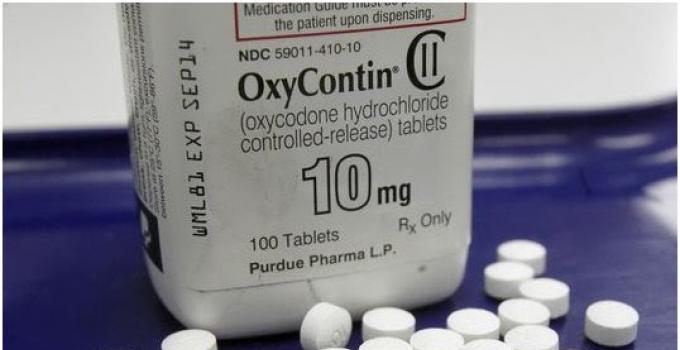(Photo: Toby Talbot, AP)
The Centers for Disease Control and Prevention warned doctors Tuesday to avoid prescribing addictive painkillers for chronic pain whenever possible, in an effort to reduce abuse and overdoses.
In its first set of guidelines for prescribing opiates, a class of morphine-like painkillers, the CDC said the risks of the medications outweigh the benefits for most people with long-term pain, other than patients being treated for cancer or those at the end of life.
The USA is in the grips of an epidemic of prescription painkiller abuse, with 40 Americans a day dying from overdoses, according to the CDC. In 2013, an estimated 1.9 million people abused or were dependent on prescription opiates.
Nearly all of the prescription opiates on the market are as addictive as heroin, said CDC director Thomas Frieden. Yet prescription opiates often do a very poor job in controlling chronic pain. Some patients who are prescribed opiates actually experience more pain than others, Frieden said.
"We know of no other medication routinely used for a nonfatal condition that kills patients so frequently," Frieden said. "We hope to see fewer deaths from opiates. That's the bottom line. These are really dangerous medications that carry the risk of addiction and death."
The CDC's 12 new guidelines are intended for primary care physicians, who prescribe nearly half of opiates. Doctors aren't legally obligated to follow the recommendations.
The recommendations aim to help doctors determine when to begin or continue opiates for chronic pain; how to choose opiates and for how long; and how to weigh the drugs' risks and harms, according to the CDC.
When treating chronic pain, doctors should use therapies other than opiates first, such as exercise or non-steroidal anti-inflammatories, such as aspirin or ibuprofen, Frieden said.
Doctors should only prescribe opiates when they expect the benefits to outweigh the risks, he said. Before starting opiates, doctors should talk to patients about their treatment goals and when to stop using opiates.
When doctors do prescribe opiates, they should use the lowest effective dose for the shortest amount of time, Frieden said. Patients with acute pain, such as that caused by an injury, usually need prescription opiates for only three days. Prescribing the drugs for more than seven days is rarely needed, he said. "When opiates are used, start low and go slow," Frieden said, meaning that doctors should increase the dose of medication slowly and only when absolutely necessary.
Doctors should check every three months to see if the benefits of opiates continue to outweigh the risks, according to the guidelines.
If patients abuse opiates, doctors should help them get treatment that's supported by strong medical evidence, such as the therapies buprenorphine or methadone, according to the guidelines.
The new CDC guidelines are "a game changer," said Andrew Kolodny, executive director of Physicians for Responsible Opioid Prescribing. Doctors respect the CDC and are likely to be influenced by its guidance, he said.
"For the first time, the federal government is communicating clearly that the widespread practice of treating common pain conditions with long-term opioids is inappropriate," said Kolodny, a senior scientist with the Heller School for Social Policy and Management at Brandeis University. "The CDC is making it perfectly clear that medical practice needs to change because we’re harming pain patients and fueling a public health crisis."
Telling patients and doctors that opiates are rarely needed for more than a few days "will help prevent patients from getting addicted and help keep highly addictive drugs from accumulating in medicine chests," Kolodny said.
The hard line on opiates is a major shift from conventional wisdom about relieving pain.
Although there has never been much evidence that opiates relieve chronic pain, doctors were told for decades to consider pain as a "vital sign" that needed to be addressed, wrote addiction medicine specialist Yngvild Olsen, medical director of Reach Health Services in Baltimore, in an editorial in JAMA. That advice to manage patients' pain was accompanied by "misleading marketing of prescription opioids by manufacturers, who minimized the risks of misuse and addiction," she wrote.
The pressure to treat manage led many doctors to "miss or dismiss the presence of addiction in their patients," Olsen wrote.
Patients should ask questions if their doctors want to prescribe them opiates, said Deborah Dowell, senior medical adviser in the division of unintentional injury prevention at the CDC’s National Center for Injury Prevention and Control. Key questions to ask include: Is an opiate necessary? What are the risks? What are the benefits? How long should I take this? Are there alternatives? What we hope to accomplish by using an opiate? How will you know when we've met our goal?
Sen. Edward Markey, D-Mass. praised the CDC for releasing the guidance.
“Just as we need rules of the road to prevent injury and death, we need strong guidelines that can help prevent abuse of and addiction to opioid painkillers,” Markey said in a statement.
“While these are important measures we need prescribers to take, they are just guidelines and we need requirements to ensure all prescribers of opioid painkillers are educated in safe prescribing practices and the identification of possible substance use disorders," Markey said. "I will continue to work with my congressional colleagues to pass legislation that ensures all prescribers of opioid pain medication get the education needed to help prevent addiction before it takes any more lives of our friends, families and loved ones.”

